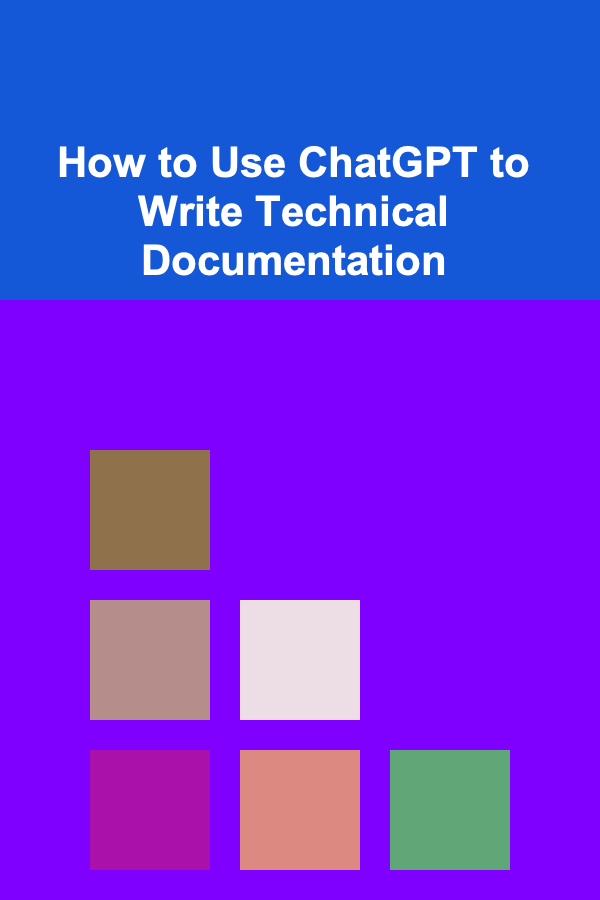
How to Use ChatGPT to Write Technical Documentation
ebook include PDF & Audio bundle (Micro Guide)
$12.99$11.99
Limited Time Offer! Order within the next:

In the fast-paced world of software development, technical documentation plays a crucial role in ensuring that complex systems, applications, and codebases are understandable and usable for developers, engineers, and other stakeholders. However, writing clear, accurate, and comprehensive technical documentation can be a daunting task. Fortunately, with the advent of AI tools like ChatGPT, the process can be made significantly easier and more efficient.
ChatGPT, a state-of-the-art language model developed by OpenAI, has the potential to revolutionize how technical documentation is created. By leveraging its capabilities, you can automate certain aspects of documentation, enhance the clarity of your writing, and save valuable time. In this article, we will explore how to use ChatGPT effectively to write high-quality technical documentation.
Understanding the Role of Technical Documentation
Before diving into how ChatGPT can be used to write technical documentation, it's essential to understand what technical documentation is and why it's important. Technical documentation provides written instructions and explanations about software, hardware, or systems. It includes everything from API documentation to user guides, installation manuals, and system architecture diagrams.
Effective technical documentation serves several purposes:
- Improves Communication: It helps developers, engineers, and non-technical stakeholders understand complex systems and processes.
- Enhances Productivity: Well-written documentation can make the onboarding process easier, reducing time spent on training and troubleshooting.
- Ensures Maintainability: Clear documentation makes it easier to maintain, upgrade, and debug systems in the future.
- Facilitates Collaboration: It promotes teamwork by providing a common reference point for developers, testers, and other stakeholders.
With such a critical role, the quality of technical documentation can directly impact the efficiency and success of a project. However, producing high-quality documentation is often a time-consuming and challenging task.
The Challenges of Writing Technical Documentation
Writing technical documentation is not without its challenges. Some of the key hurdles include:
- Complexity: Technical documentation often deals with intricate, detailed concepts that need to be broken down into digestible information for a wide range of audiences.
- Clarity: Writing clearly is essential, as ambiguity can lead to misunderstandings or misuse of the system being documented.
- Consistency: Maintaining a consistent style and structure across documentation is crucial for readability and accessibility.
- Time Consumption: Writing, editing, and maintaining documentation can take a significant amount of time, especially for large-scale projects.
- Lack of Expertise: Not everyone is skilled in writing technical content. Engineers, developers, and other technical professionals may be experts in their field but struggle to translate their knowledge into readable documentation.
These challenges are where ChatGPT can be incredibly useful.
How ChatGPT Can Help Write Technical Documentation
ChatGPT can assist in many aspects of the technical documentation process, from content generation to structure, clarity, and language refinement. Below are several ways in which you can use ChatGPT to improve and streamline the process of writing technical documentation.
1. Generating Boilerplate Text
Many technical documents follow a similar structure, especially when writing API documentation, installation guides, or user manuals. ChatGPT can generate boilerplate text that forms the foundation of your documentation. For example, it can help create standardized introductory paragraphs, code explanation templates, and default sections like "Requirements," "Installation," and "Usage."
Example:
You could prompt ChatGPT to generate an introductory section for a user guide:
"Generate an introductory section for a user guide for a weather forecasting app, explaining the purpose of the app, its features, and its requirements."
ChatGPT would respond with something like:
Introduction
Welcome to the user guide for the Weather Forecasting App! This application provides accurate, up-to-date weather forecasts, helping you stay prepared for changing weather conditions. With features such as hourly forecasts, weekly predictions, and severe weather alerts, the Weather Forecasting App is your trusted companion for planning your day.
Before getting started, make sure that your device meets the following requirements:
- A stable internet connection
- Android 5.0 or higher / iOS 12.0 or higher
- Location services enabled for personalized forecasts
2. Clarifying Technical Jargon
One of the most common issues in technical documentation is the use of jargon and complex terminology that may not be easily understood by all users. ChatGPT can help rewrite complicated technical descriptions in simpler terms, making the documentation more accessible to a broader audience.
Example:
If you have a section that explains a technical concept like "asynchronous programming" but is too complicated for a non-developer audience, you could ask ChatGPT to simplify it.
"Explain asynchronous programming in simple terms for beginners."
ChatGPT might provide an explanation like:
Asynchronous Programming
Asynchronous programming is a way of handling tasks that take time to complete without blocking other tasks from running. Imagine you ask your friend to bake a cake. While the cake is baking, your friend can do other things, like washing dishes or setting the table. In programming, asynchronous operations work in a similar way. Instead of waiting for a long task, like downloading a file, to finish before starting something else, the program can move on to other tasks and come back to the original task once it's done.
3. Generating Example Code Snippets
When writing technical documentation for developers, it's often necessary to include code examples to demonstrate how certain features or functions work. ChatGPT can generate code snippets based on your requirements, helping you provide clear and correct examples to users.
Example:
Suppose you're writing API documentation and need to provide an example of how to authenticate using an API key. You could prompt ChatGPT with:
"Generate a Python code snippet that demonstrates how to authenticate using an API key in an HTTP request."
ChatGPT would generate something like this:
api_url = "https://api.example.com/data"
headers = {
"Authorization": "Bearer YOUR_API_KEY"
}
response = requests.get(api_url, headers=headers)
if response.status_code == 200:
print("Request successful:", response.json())
else:
print("Error:", response.status_code)
This code snippet demonstrates how to authenticate using an API key and handle the response.
4. Improving Document Structure and Formatting
Technical documentation must be well-structured to be effective. ChatGPT can assist in organizing content logically and ensuring that the document flows coherently. It can suggest headings, subheadings, bullet points, and numbered lists to break up large blocks of text and make the documentation more readable.
For example, if you are documenting a process and need to break it down into easy-to-follow steps, ChatGPT can assist you in creating numbered lists that enhance the readability of your documentation.
Example:
"Describe how to install a software application on Windows step-by-step."
ChatGPT might output something like:
Installing the Software on Windows
To install the software on your Windows computer, follow these steps:
- Download the installation file from the official website.
- Open the downloaded file to begin the installation process.
- Follow the on-screen instructions and click 'Next' until the installation is complete.
- Once installed, launch the application by clicking the shortcut on your desktop.
5. Editing for Grammar and Style
ChatGPT can also act as a proofreading tool. It can help identify and correct grammatical errors, suggest improvements for readability, and ensure consistency in tone and style. If you've written a section of documentation that feels awkward or unclear, you can ask ChatGPT to rephrase it.
Example:
You might input a sentence like:
"To get started, first you have to download and install the software."
ChatGPT could suggest the following revision:
"To get started, download and install the software."
This change improves the clarity and conciseness of the sentence.
6. Automating FAQ Sections
Frequently asked questions (FAQs) are an integral part of technical documentation. ChatGPT can generate answers to common questions that users may have, based on your product or service.
Example:
"Generate a list of FAQs for a cloud-based file storage service."
ChatGPT might provide:
FAQs for Cloud-Based File Storage Service
-
How do I upload files to the cloud?
To upload files, simply drag and drop them into the designated folder in your cloud dashboard, or click the 'Upload' button and select the files from your computer.
-
Can I access my files from multiple devices?
Yes, your files are synced across all devices connected to your account, so you can access them from anywhere.
-
What happens if I exceed my storage limit?
If you exceed your storage limit, you will be prompted to upgrade to a higher plan to continue storing your files.
7. Summarizing and Reviewing Long Documents
If you're working with lengthy technical documents, ChatGPT can help summarize the content and create concise versions of large sections. This is particularly useful when you need to create executive summaries or when you're preparing documentation for a non-technical audience.
Example:
"Summarize the following section on API authentication methods."
ChatGPT could provide a brief summary:
API Authentication Methods
There are several methods for authenticating API requests, including API keys, OAuth tokens, and session cookies. Each method has its own security protocols and use cases, depending on the sensitivity of the data and the level of user interaction required.
Conclusion
Writing technical documentation can be challenging, but with tools like ChatGPT, it doesn't have to be overwhelming. By leveraging ChatGPT's capabilities to generate content, clarify technical jargon, provide code snippets, improve readability, and more, technical writers can streamline their workflow, save time, and produce high-quality documentation that meets the needs of developers and end-users alike. Whether you're writing API documentation, user guides, or system manuals, ChatGPT can be an invaluable resource for creating clear, comprehensive, and effective technical documentation.

How to Create a Checklist for Disaster Recovery for Healthcare Providers
Read More
How to Create a Family Scrapbook for the Holidays
Read More
How to Create a Memory Jar for Sharing Stories
Read More
How to Identify Fake Antiques and Avoid Scams
Read More
How to Use a Reception Venue Checklist for Multi-Cultural Weddings
Read More
How to Track Property Taxes as a Landlord
Read MoreOther Products

How to Create a Checklist for Disaster Recovery for Healthcare Providers
Read More
How to Create a Family Scrapbook for the Holidays
Read More
How to Create a Memory Jar for Sharing Stories
Read More
How to Identify Fake Antiques and Avoid Scams
Read More
How to Use a Reception Venue Checklist for Multi-Cultural Weddings
Read More